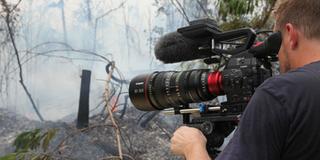Showtime Chooses Canon for “Years of Living Dangerously”

NEW YORK—Showtime’s “Years of Living Dangerously,” a documentary about climate change, deployed Canon EOS C300 digital cinema cameras and Canon optics, including CN-E Cinema prime lenses.
Years of Living Dangerously executive producers include James Cameron, Jerry Weintraub, Arnold Swartzenegger, Joel Bach and David Gelber and climate change expert Daniel Abbasi. Co-executive producers are Solly Granatstein and Maria Wilhelm.
Filming sometimes required three crews working simultaneously in different locations and up to six Canon EOS C300 cameras rolling.
One of several digital photographers working on the series is Wolfgang Held, who notes the EOS C300 camera has become his “main camera” and the one he now recommends most often to other DPs.
“The EOS C300 camera image quality is beautiful, yet the camera is also travelable, and it doesn’t need a big crew to manage it, as some other digital cinematography cameras do,” said film shooter Wolfgang Held. “The combination of the lightweight, ergonomic EOS C300 camera and the compact Canon EF lenses I can use with it lets me shoot one-man cinéma vérité style, and pull my own focus as I follow live events.”
Line producer Jennifer Latham noted that another advantage of the Canon EOS C300 camera is its ability to be used with Canon’s line of more than 60 interchangeable EF Series lenses or Canon’s set of EF-mount Cinema prime lenses and four Cinema zoom lenses.
“My workhorse is the Canon EF 24-105mm f/4L IS USM zoom,” said Held. “The lens has a built-in image stabilizer and the perfect zoom range for shooting cinema vérité, where I follow people and capture what’s happening to them live. This lens allows me to do that. We also took advantage of the compact size of the Canon EF 16-35mm ultra-wide zoom lens to shoot inside cars.”
“Shooting interviews with the Canon EF 70-200mm zoom, and sometimes even using its 2x extender, lets us keep the EOS C300 cameras really far away so that conversations can play out without having cameras lurking right near by,” Bach said.
“I’ve been using the CN-E24mm, CN-E50mm and the CN-E85mm,” Held said. “The image quality you get by combining the large lens elements in those primes with the big imager in the rugged and portable EOS C300 camera is amazing.”
The Canon EOS C300 camera can be hand-held by its removable, rotating side pistol grip or by its detachable top handle, or used with a wide variety of third-party support devices. For Held, this means holding the Canon EOS C300 camera by its detachable top handle with the camera’s also detachable LCD monitor unit attached. In addition to a fold-down 4-in. 1.23 megapixel LCD monitor (which rotates 135˚ left/right or 270˚ down for convenient operator positioning), the monitor unit includes multiple camera-function buttons.
“I use one of the function buttons on the monitor unit to dial-in my ISO as I’m shooting. I can fine-tune the ISO to stay at a certain f-stop when I’m shooting outside and the sun is going in and out, or if I’m going from a dark to a brighter place,” said Held. “The function button allows me to fine-tune my exposure without having to put the camera down and go to the menu.”
“The camera has great compression in terms of file size,” said Latham.
Smooth postproduction workflow for the EOS C300 is enabled by its employment of the Material eXchange Format container file format for compatibility with major editing software and systems. In addition, the EOS C300 camera offers the Canon Log recording mode, which helps ensure capture of a full 12 T-stops of exposure latitude.
Get the TV Tech Newsletter
The professional video industry's #1 source for news, trends and product and tech information. Sign up below.
